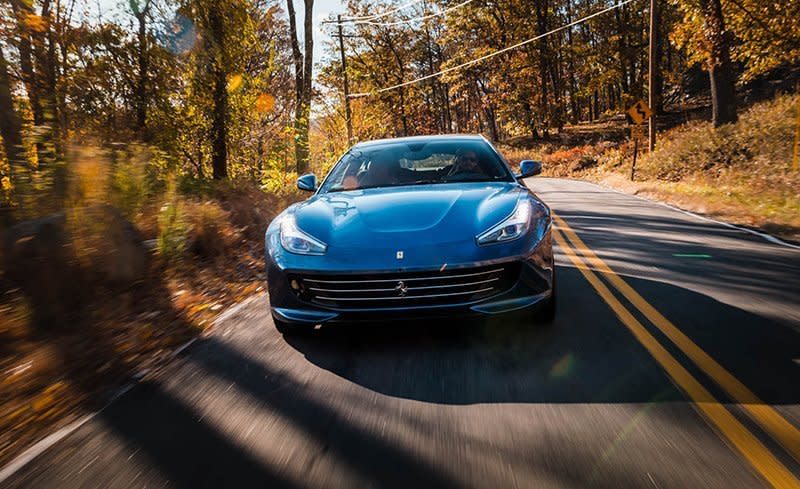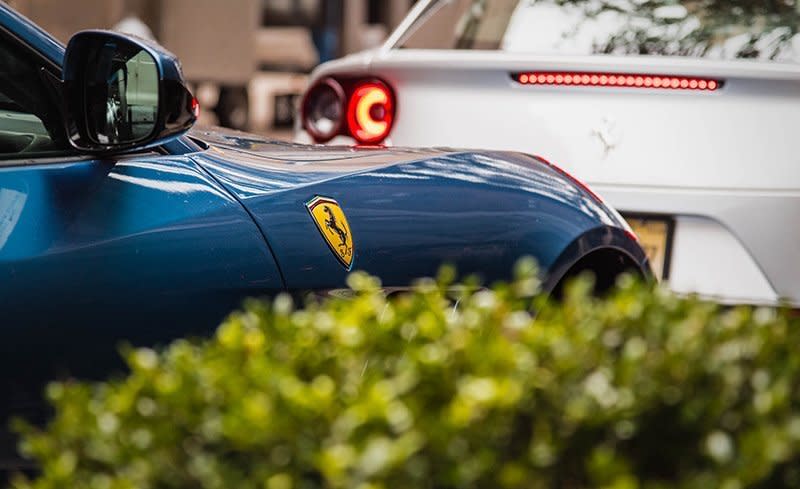2018 Ferrari GTC4Lusso T

Ferrari offers its buyers myriad customization options, but this “choice is yours” philosophy generally doesn’t extend to powertrains. And yet that’s what we have with the introduction of the GTC4Lusso T, which offers a twin-turbocharged V-8 rather than the GTC4Lusso’s naturally aspirated V-12.
The GTC4Lusso, you’ll recall, is an evolution of the pioneering Ferrari FF, the 2012 model that brought a shooting-brake body style and all-wheel drive to the four-place Ferrari grand touring car. The GTC4Lusso massaged the styling (to pleasing effect), as well as other aspects of the car, but left the powertrain layout alone. The Lusso T, which will be sold alongside the Lusso, uses Ferrari’s twin-turbocharged 3.9-liter V-8 seen also in the Portofino. (The 488GTB’s 3.9-liter is slightly different, with a 1.0-millimeter-longer stroke.)

This isn’t just an engine swap, however. The Lusso T also ditches the V-12 car’s complicated and unusual all-wheel-drive system in favor of simpler, lighter rear-wheel drive. The sum of those two changes results in a claimed weight loss of 121 pounds. As that reduction all comes off the front end, the rear weight bias increases to 54 percent from 53.
Heart Transplant
The V-8, though, is the heart of the matter. Compared with the older, shorter-stroke 3.9 in the California T, the flat-plane-crankshaft V-8 gets new pistons and intercoolers, a revised air intake, and a new exhaust system. Max output is 602 horsepower at 7500 rpm versus 591 for the Portofino and 661 for the 488GTB, while peak torque for all three is an identical 561 lb-ft at 3000 rpm. The V-12 in the GTC4Lusso makes another 78 horsepower, which comes 500 rpm higher up the tach, but less torque: 514 lb-ft at 5750 rpm.
Ferrari claims the V-8 car is just 0.1 second behind the V-12 in the sprint from zero to 62 mph (3.5 seconds versus 3.4), while its top speed is 199 mph against the 12-pot’s 208. Still, there’s little danger of the GTC4Lusso T getting left behind at a stoplight. Paired with Ferrari’s seven-speed dual-clutch automatic transaxle, response is immediate and turbo lag is a nonissue. There’s all kinds of power here, and without all-wheel drive to help get the grunt to the ground, a stab of the throttle at 50 mph or even quickly jumping out into traffic is enough to give the traction control a quick workout. At any speed, frenetic acceleration is just an ankle flex away. This car loves to blur the scenery; it’s hard to imagine the Lusso T driver is giving up much compared to the V-12.

Sound Off
There are more subjective measures, however. Ferrari points to the V-8’s flat-plane crankshaft and equal-length exhaust manifolds as key elements in delivering an exotic wail despite the muffling effect of turbochargers. When the revs climb past 5000 rpm, on the way to the 7500-rpm redline, the engine delivers that exotic Ferrari sound. Below, that, however, this engine is fairly muted, and the exhaust note is more mundane. The manettino selector’s Sport setting opens a flap in the exhaust, but the note seems to change only under light-throttle cruising. Come to a stop, and the engine goes silent; this is rectified by switching off the standard auto stop/start via a button on the windshield header.
Ferrari says it wanted the lighter, rear-drive Lusso T to have a sportier feel than the V-12 model and that it reprogrammed the electronically controlled dampers and four-wheel-steering system accordingly. That may be the case, but we suspect that where any such differences become evident is far outside the realm most drivers will experience every day. In our roughly 150-mile drive in New York City and its northern environs, we found the GTC4Lusso T to be very much a grand tourer.
To start with, the car is exceedingly comfortable. The magnetorheological dampers do a superb job even over the beat-up pavement one finds in upper Manhattan and on the Major Deegan Expressway in the Bronx. Switching between Comfort and Sport mode has little effect on the ride.

The helm is light. There’s an immediacy to it that may be due to the four-wheel steering—at higher speeds the rear wheels turn in phase with the fronts—or the rack’s ultraquick 2.3 turns lock to lock. Fortunately, the steering wheel is a precision instrument, which helps tremendously when placing this big car, even on narrow lanes like those of the Taconic State Parkway. In faster corners, the Lusso T responds faithfully and feels utterly balanced. Like the steering, the standard carbon-ceramic brake rotors and massive calipers are highly responsive, even at the very top of the pedal’s travel. Again, precise inputs are a must.
Soothing Environs
As befits a grand tourer, the Lusso T’s cabin is sybaritic. The driver’s chair offers tremendous thigh support. Seeing out of this Ferrari is easier than in most high-performance coupes, owing to the generous glass area and relatively narrow pillars. The optional panoramic glass roof was fitted to the car we drove, and it further brightens the interior—while surely adding substantial mass, if you're the type to care about such things.
Rich leather—in your choice of more than a dozen colors—covers every interior surface that’s not carbon fiber or brushed metal. Hard plastic is banished from the cabin. As in other Ferraris, a large tachometer takes pride of place in front of the driver, with a digital gear readout contained within. Flanking it are two configurable screens. The right one can be a speedometer gauge, but the digital speed readout—pretty important in a Ferrari—is a small readout beneath the left screen. The dash features a 10.3-inch central touchscreen, abetted by a few knobs and buttons. Apple CarPlay functionality is optional for a whopping $3900.

The steering wheel is a complicated, Formula 1–style affair adorned with all manner of controls, including push buttons on the spokes for the turn signals, an ignition button, the wiper switch, and the driving-mode manettino knob, but acclimating to all of it is surprisingly easy. Our Lusso T also had optional LEDs at the top of the rim that illuminate as you approach redline, a neat flourish. Behind the wheel are the oversize, carbon-fiber shift paddles, which you’ll want to play with just because they’re so tactile.
In the GTC4Lusso T, your passenger is your copilot, so Ferrari offers an optional 8.8-inch multifunction touchscreen for the front rider, who can even look up a point of interest and send it to the main navigation screen. Ferrari has carved out a bit more rear-seat legroom than in the FF (although the wheelbase is identical), and a six-footer can wedge in behind a similarly sized driver—just don’t expect much wiggle room. The rear chairs are comfortable, though, and offer a decent view out. The seatbacks fold to expand the cargo hold, perfect for a couple who doesn’t understand the concept of packing light.

Note that a Ferrari, even a GT like this one, is still a car you actively drive. There’s no semi-autonomous, self-steering capability; there’s no lane-keeping assist, no automated emergency braking, not even adaptive cruise control. And yet, despite the march of technology, this approach seems appropriate here.
This Ferrari is a car you’ll enjoy driving. But would you enjoy the V-12 more? Perhaps. There is the compensating factor of the roughly $40K you’ll save by opting for the V-8, but in the realm of $300,000 GTs, maybe that’s not a big deal. We expect the savings at the pump isn’t either, although we’ll note the V-8 is rated at 17 mpg combined, 4 mpg better than the V-12—which consequently extends the car’s fuel range. Visually, the two Lusso variants are equally impactful: The only evident differences between them are the designs of the wheels and the exhaust tips. The GTC4Lusso T is a magnificent machine, but given the choice—and in this case, we are—we’d take our front-engine Ferrari with 12 cylinders.
Specifications >
VEHICLE TYPE: front-engine, rear-wheel-drive, 4-passenger, 2-door hatchback
BASE PRICE: $260,750
ENGINE TYPE: twin-turbocharged and intercooled DOHC 32-valve V-8, aluminum block and heads, direct fuel injection
Displacement: 235 cu in, 3855 cc
Power: 602 hp @ 7500 rpm
Torque: 561 lb-ft @ 3000 rpm
TRANSMISSION: 7-speed dual-clutch automatic with manual shifting mode
DIMENSIONS:
Wheelbase: 117.7 in
Length: 193.8 in
Width: 78.0 in Height: 54.4 in
Cargo volume: 16 cu ft
Curb weight (C/D est): 4150 lb
PERFORMANCE (C/D EST):
Zero to 60 mph: 3.6 sec
Zero to 100 mph: 7.9 sec
Standing ¼-mile: 11.5 sec
Top speed: 199 mph
EPA FUEL ECONOMY:
Combined/city/highway: 17/15/21 mpg

 Yahoo Autos
Yahoo Autos 